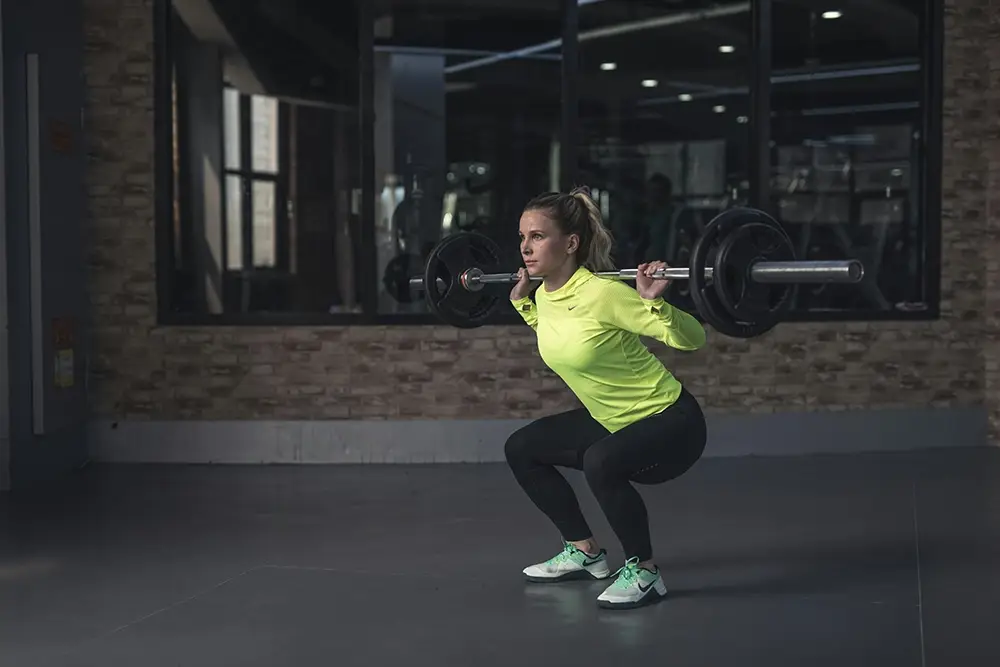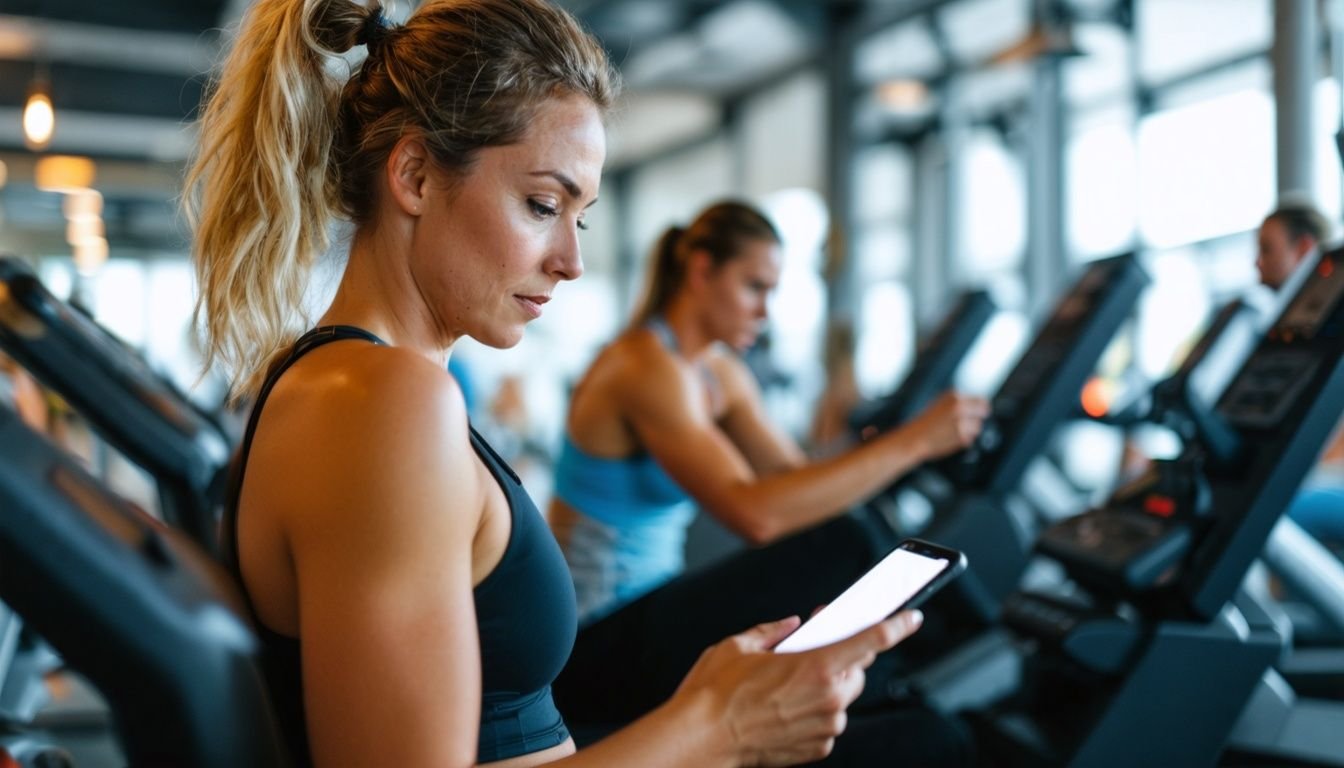Getting the squat right can be a game-changer. Many gym-goers struggle with it, unsure if their form is good or bad. Are you one of them? Squatting properly isn’t just about avoiding injury; it’s also key to getting stronger and fitter faster.
Here’s something to consider: Feet must stand shoulder-width apart during a squat for stability and power. This article breaks down the art of squatting correctly – from foot placement to knee alignment and core engagement.
We’ll guide you through mastering this essential movement, step by confident step. Keep reading to transform your squats!
Benefits of Proper Squat Technique
Proper squat technique offers improved strength and mobility, time-saving during workouts, and functional gains that enhance daily activities.
Improved strength and mobility
Squatting with proper form significantly boosts both strength and flexibility throughout the body. The act of maintaining an upright torso, as advised during a squat, engages multiple muscle groups simultaneously, from the core stabilizing muscles to the lower body powerhouses like glutes and quads.
This orchestrated effort not only enhances muscular strength but also promotes joint health by ensuring knees track over toes effectively without extending past them.
Incorporating squats into your routine improves mobility, especially in the hips and ankles, which is vital for performing daily activities with ease. Perfecting squat technique involves bending knees while sticking hips back and keeping feet shoulder-width apart ensures that all movements are smooth and coordinated.
This practice trains the body to move more efficiently, reducing the risk of injury during exercise or everyday tasks.
Time-saving
Mastering the squat technique not only enhances strength and mobility but also offers a time-saving workout option. By incorporating squats into your fitness routine, you can efficiently target multiple muscle groups in a single exercise, maximizing your workout time.
This compound movement engages various muscles simultaneously, such as the quadriceps, hamstrings, glutes, and core. Therefore, by prioritizing proper form and technique while performing squats, you can optimize the efficiency of your workouts and achieve better results in less time.
Executing squats with correct posture ensures that each repetition is impactful and serves dual purposes of strength training and cardio conditioning. The activation of numerous muscle groups during a single squatting motion saves valuable time by allowing for a comprehensive full-body workout in just one exercise.
Functional gains
Improving your squat technique can lead to functional gains in everyday movements. This includes enhanced strength and mobility, making tasks like lifting heavy objects or climbing stairs easier.
Proper squat form also supports better posture and stability, contributing to a reduced risk of falls and injuries. By engaging multiple muscle groups simultaneously through correct squatting posture, you can increase overall body coordination and balance, essential for maintaining independence as you age.
How to Perform the Perfect Squat
Master the perfect squat by following step-by-step instructions and avoiding common mistakes for optimal form. Explore modifications and variations to tailor your squatting routine to your fitness level.
Step-by-step instructions
Position your feet shoulder-width apart. Keep your back straight, shoulders underneath the pads. Bend at the knees and hips simultaneously until your thighs are parallel to the ground.
Next, rise by pushing through your heels, keeping your chest lifted and core engaged throughout the movement. Be mindful that your knees should track over (but not past) your toes and that you dip below knee height with each squat for optimal form.
To ensure proper technique, start with bodyweight squats before advancing to weighted or barbell squats. Practicing these steps will help build strength, improve muscle recruitment, and reduce the risk of injury during squats.
Common mistakes to avoid
Moving on from the step-by-step instructions, it’s essential to be aware of common mistakes when performing squats. One frequent error is allowing the knees to extend beyond the toes during a squat, which can put excessive strain on the knee joints.
Additionally, arching or rounding the back can lead to injury and diminish the effectiveness of your squat. It’s also crucial to avoid leaning too far forward or allowing your heels to lift off the ground, as this disrupts proper weight distribution and balance.
Lastly, failing to engage your core and maintain an upright torso may compromise form and reduce the benefits of squats.
It’s important for beginners especially to keep these points in mind while learning how to perform squats correctly. By recognizing and rectifying these mistakes early on, you’ll not only prevent potential injuries but also maximize strength gains and overall fitness improvements from this foundational exercise.
Modifications and variations
To add variety and challenge to your squats, consider incorporating modifications and variations. You can try adding resistance by using dumbbells, barbells, or kettlebells to increase the intensity of your workout.
Experiment with different squat stances like sumo squats or narrow stance squats to target specific muscles in your lower body. Additionally, you can explore single-leg squats or jump squats for a more dynamic and challenging exercise experience.
Incorporating these modifications and variations into your routine can help prevent plateauing and keep your workouts engaging. By introducing new challenges, you can continue making progress in strength and mobility while keeping your routine fresh and exciting.
Health Benefits of Squats
Improved joint health, injury prevention, and support for healthy bones make squats a crucial addition to any workout routine. Read on to discover more about the benefits of proper squatting techniques.
Improved joint health
Squats contribute to improved joint health by strengthening the muscles, ligaments, and tendons around the knees and hips. These exercises promote better synovial fluid production, aiding in lubricating and protecting the joints during movement.
By regularly performing squats with proper form and technique, individuals can reduce the risk of developing joint-related issues while also enhancing overall lower body stability and support.
Prevention of injuries
To prevent injuries while squatting, it is crucial to maintain proper form and technique. This includes keeping the back straight, chest proud, and core locked throughout the movement.
Additionally, ensuring that the knees track over but not past the toes, and dipping the hips below knee height can help reduce the risk of injury during squats.
Furthermore, it’s important to remember that engaging in a regular air squat using just body weight before progressing to weighted squats can help in mastering proper posture and mechanics.
Support for healthy bones
Squats play a crucial role in supporting healthy bones. By engaging multiple muscle groups, including the lower body and core, squats promote bone density and strength, which is essential for preventing osteoporosis and reducing the risk of fractures.
The load-bearing nature of squats also stimulates bone growth, making them an effective exercise for maintaining overall bone health.
It’s important to note that by regularly incorporating squats into your workout routine, you can help fortify your skeletal system against age-related degeneration. Additionally, varying squat techniques such as front squats or goblet squats can further challenge bones to adapt and grow stronger over time.
How Many Squats Should You Do a Day?
To maximize benefits, aim for 3 sets of 12-15 squats each day. Gradually increase the number as your strength and endurance improve.
Recommended frequency
To maintain and improve overall lower body strength, aim to do squats 2 to 3 times per week. Start with a comfortable number of repetitions, such as 10-15, gradually increasing based on individual fitness levels and goals.
Take at least one day of rest between squat sessions to allow muscles to recover and adapt.
Consistency is key when integrating squats into your workout routine. So focus on quality over quantity when performing each squatting movement. Remember that recovery is just as important as the exercise itself to prevent strain or injury and ensure ongoing progress in mastering this fundamental exercise for leg strength and stability.
Calorie-burning potential
To maintain a healthy weight and promote fat loss, it’s crucial to understand the calorie-burning potential of different exercises. Squats are a compound movement that activates multiple muscle groups simultaneously, making them an effective exercise for burning calories.
As per experts, a person weighing around 155 pounds can burn approximately 223 calories by performing 30 minutes of moderate-intensity squats.
When performed with proper form and technique, squats engage large muscle groups such as the quadriceps, hamstrings, glutes, and even the core. This results in a higher calorie expenditure compared to isolation exercises.
Additionally, due to their high energy demand and metabolic impact on the body post-workout, squats contribute significantly to overall calorie burning throughout the day.
By consistently incorporating squats into your workout routine along with other resistance training exercises aimed at building lean muscle mass, you can effectively increase your basal metabolic rate over time.
Conclusion
Mastering the squat is crucial for improving strength, mobility, and overall functional gains. The step-by-step instructions provided ensure that proper form can be easily achieved.
Following these tips will not only lead to improved joint health but also reduce the risk of injuries in the long run. How many squats you should do a day is made clear based on recommended frequency and calorie-burning potential.
Implementing these practical strategies can significantly impact your fitness journey. Practice diligently and enjoy the benefits of properly executed squats!
— Article End —
Default Meta Title: Master the Art of Squatting: A Step-by-Step Guide
Default Meta Description: Master the art of proper squatting for strength and stability. Learn the right foot placement, knee alignment, and core engagement techniques. Squat with confidence!





